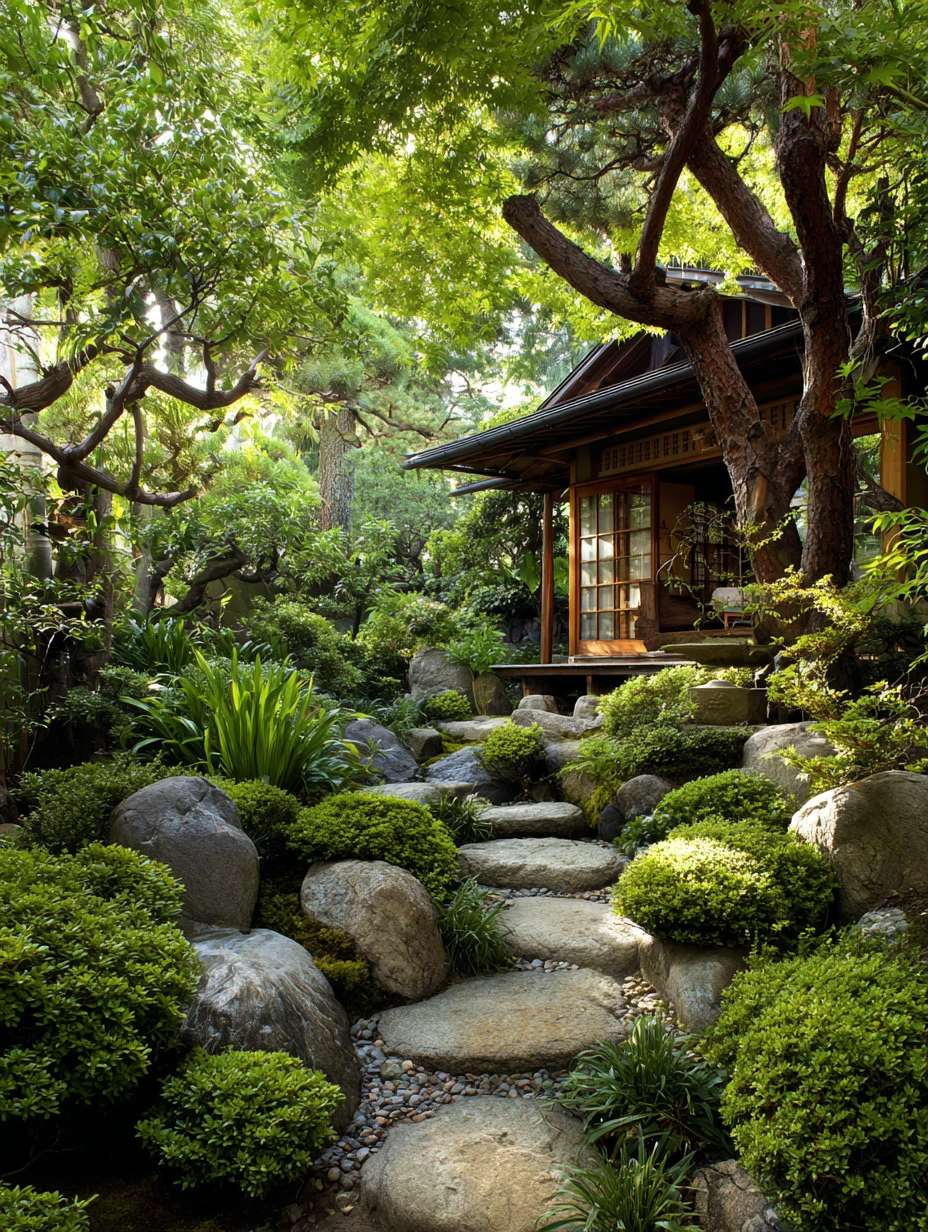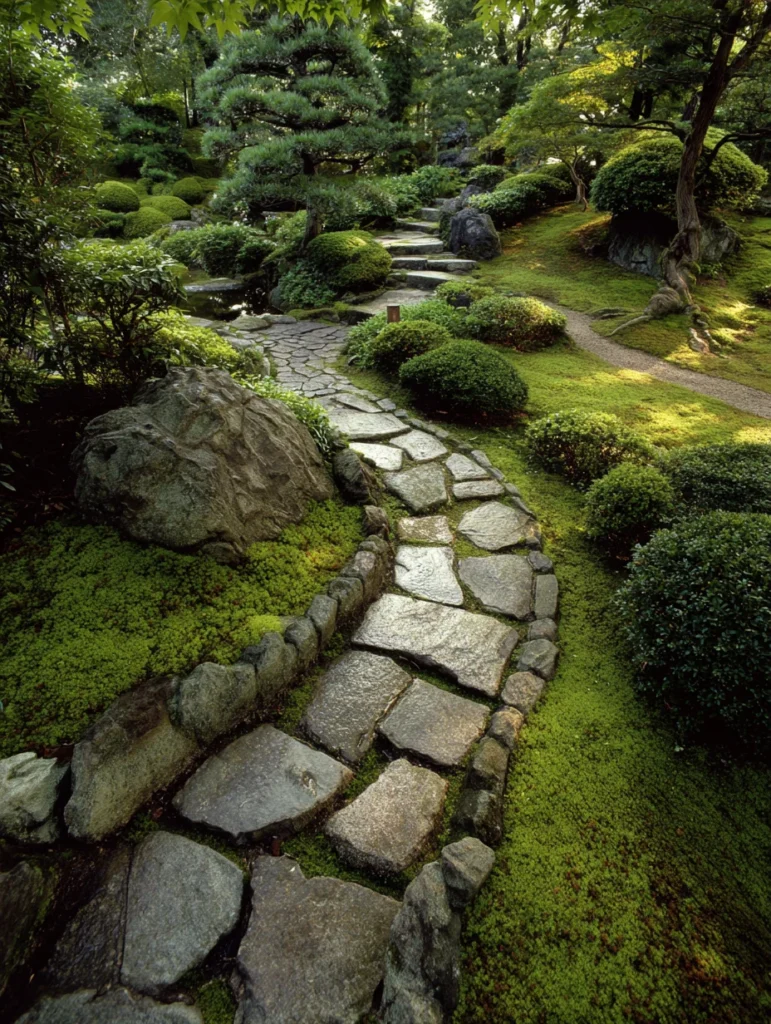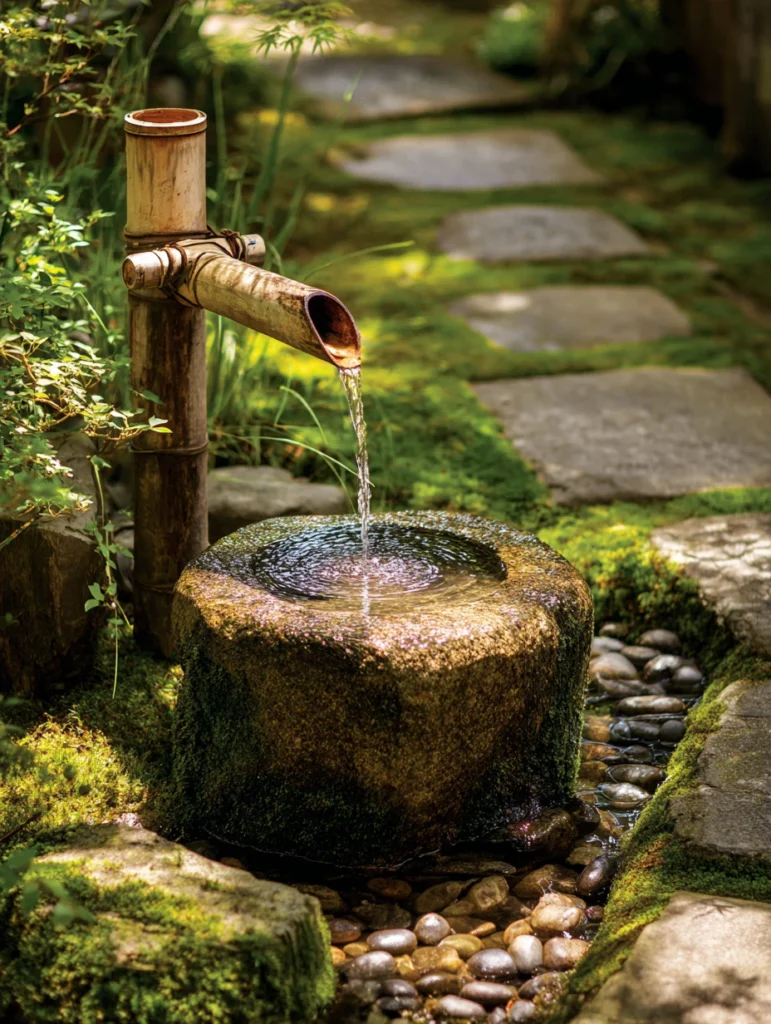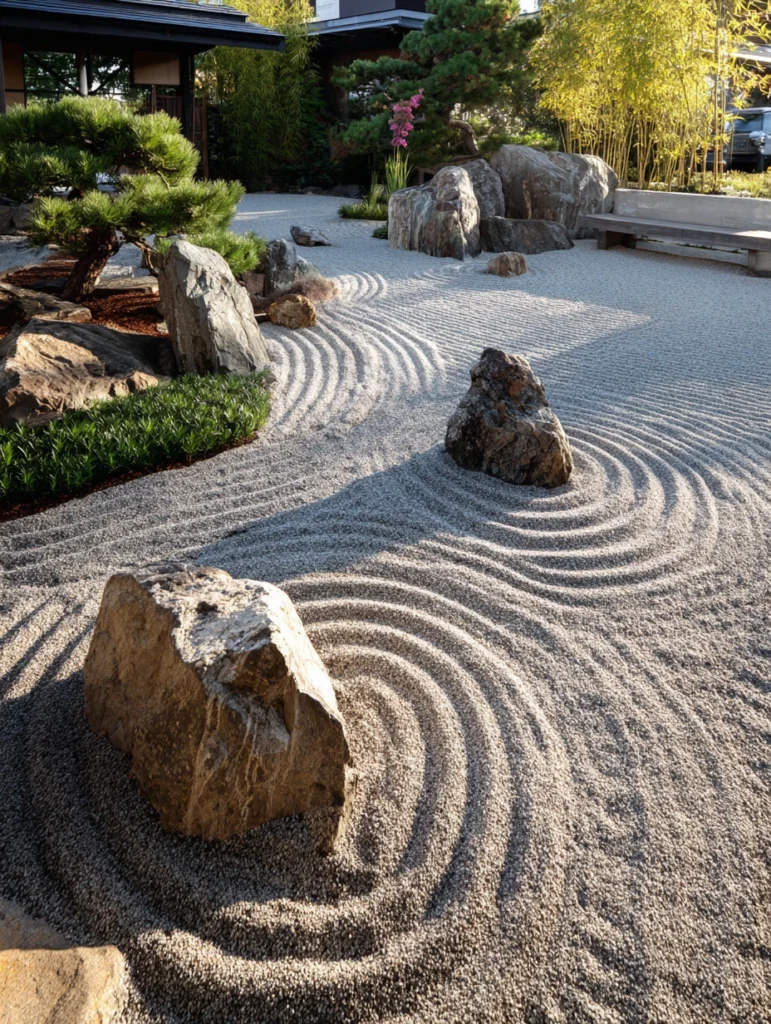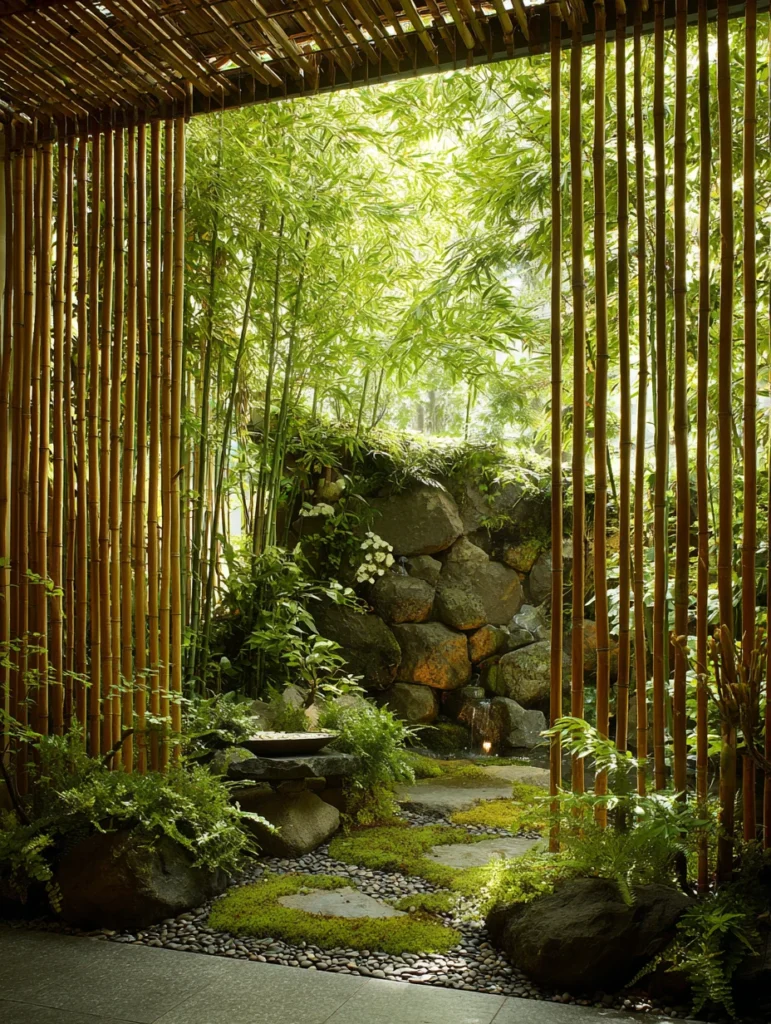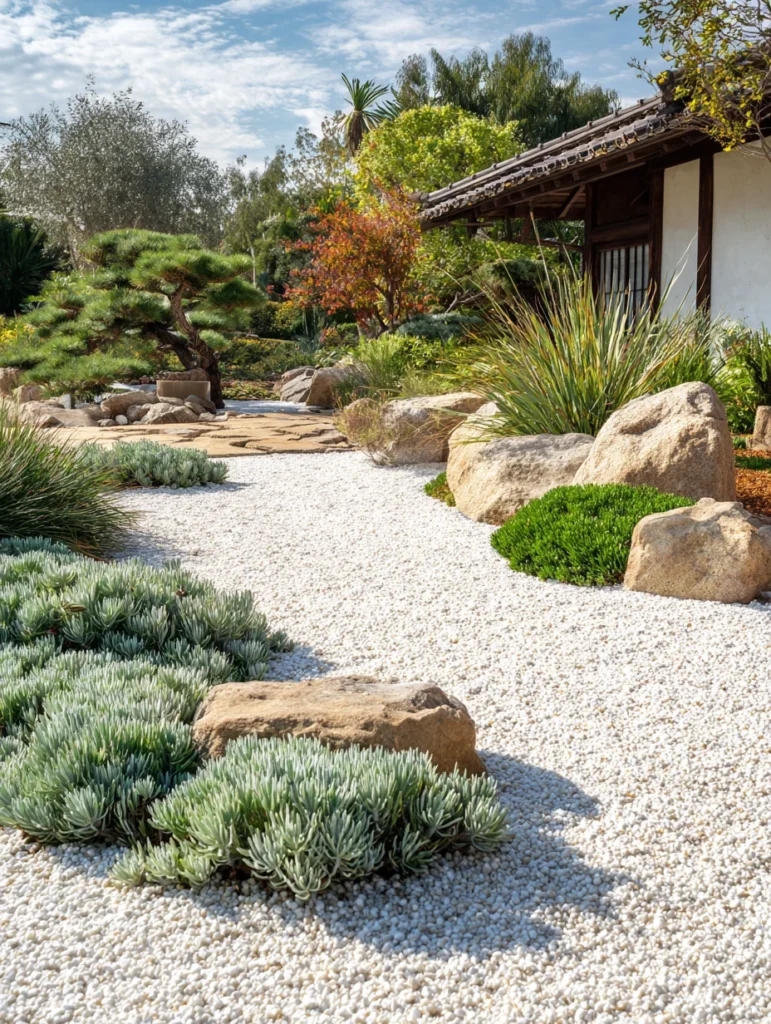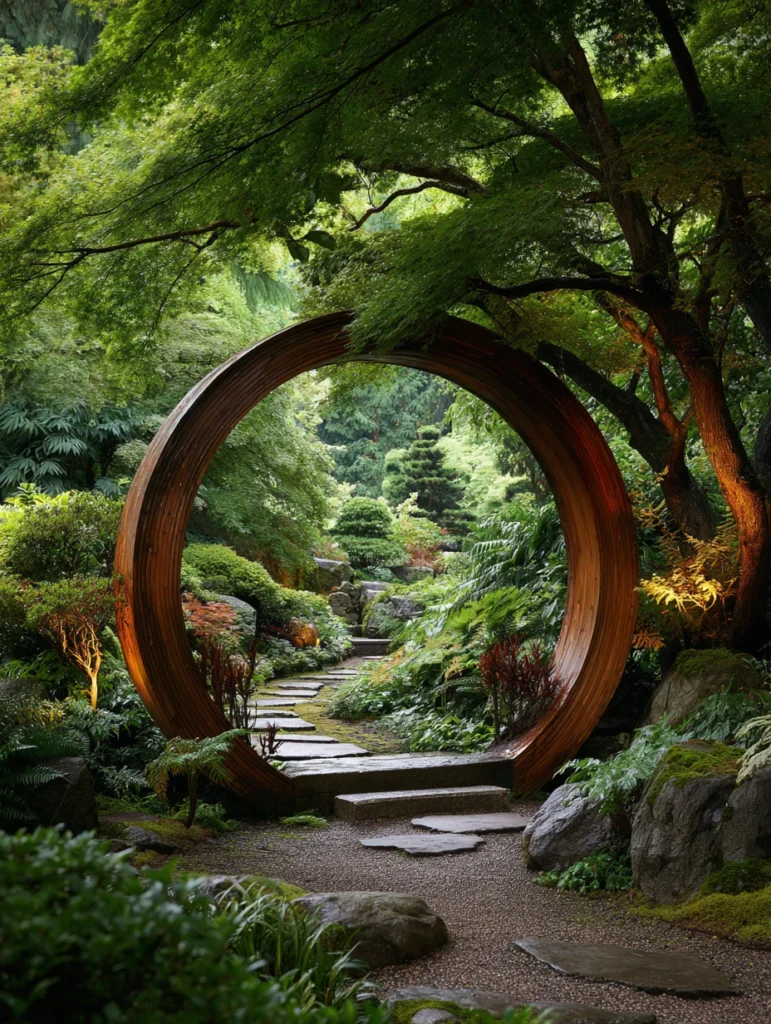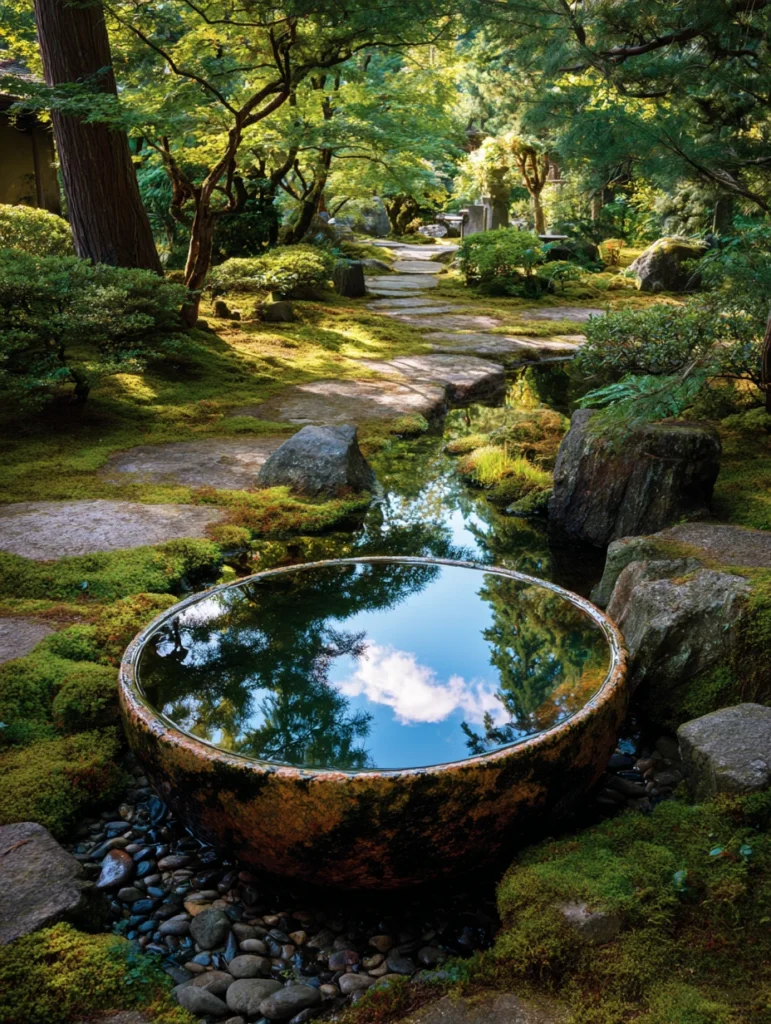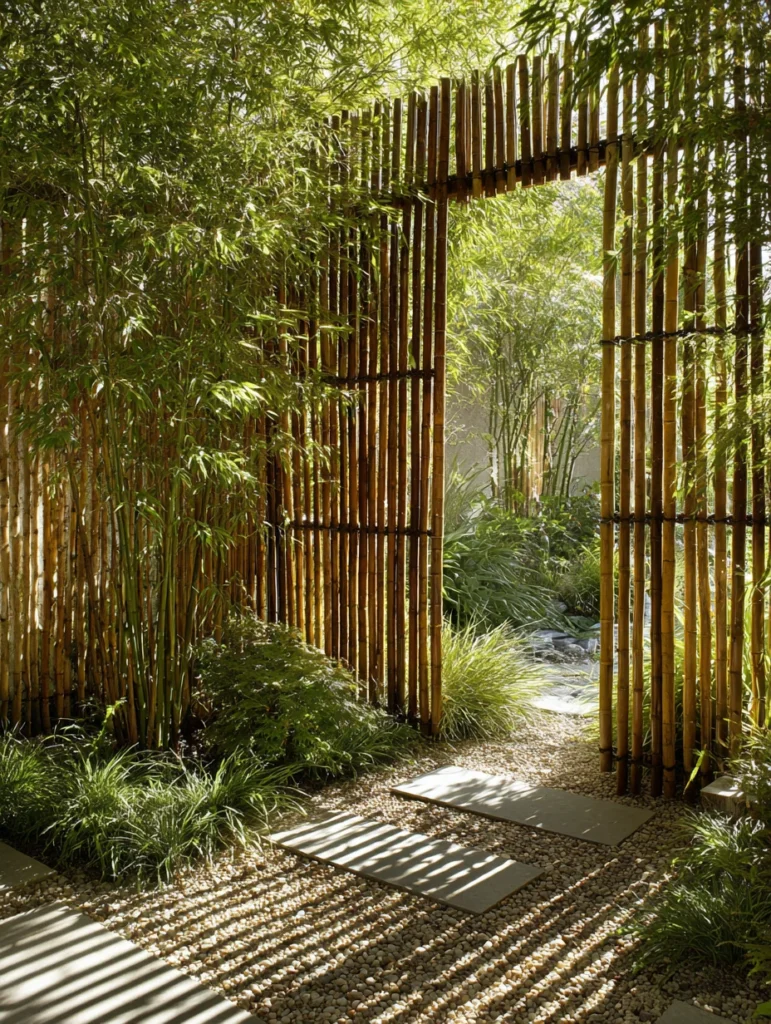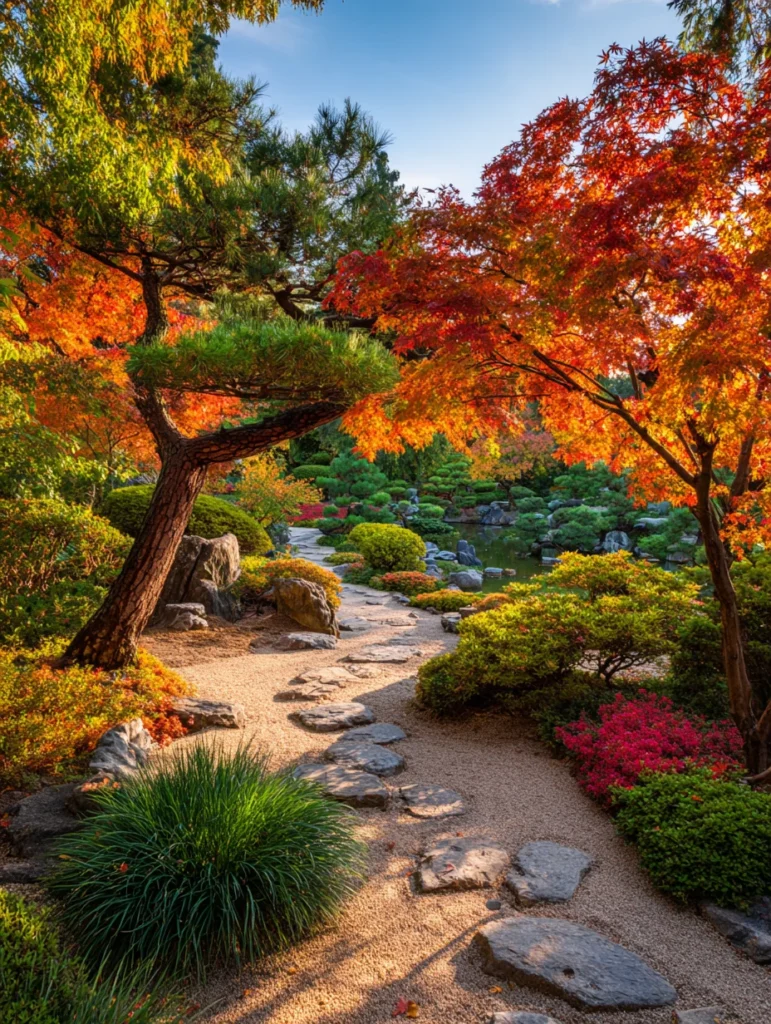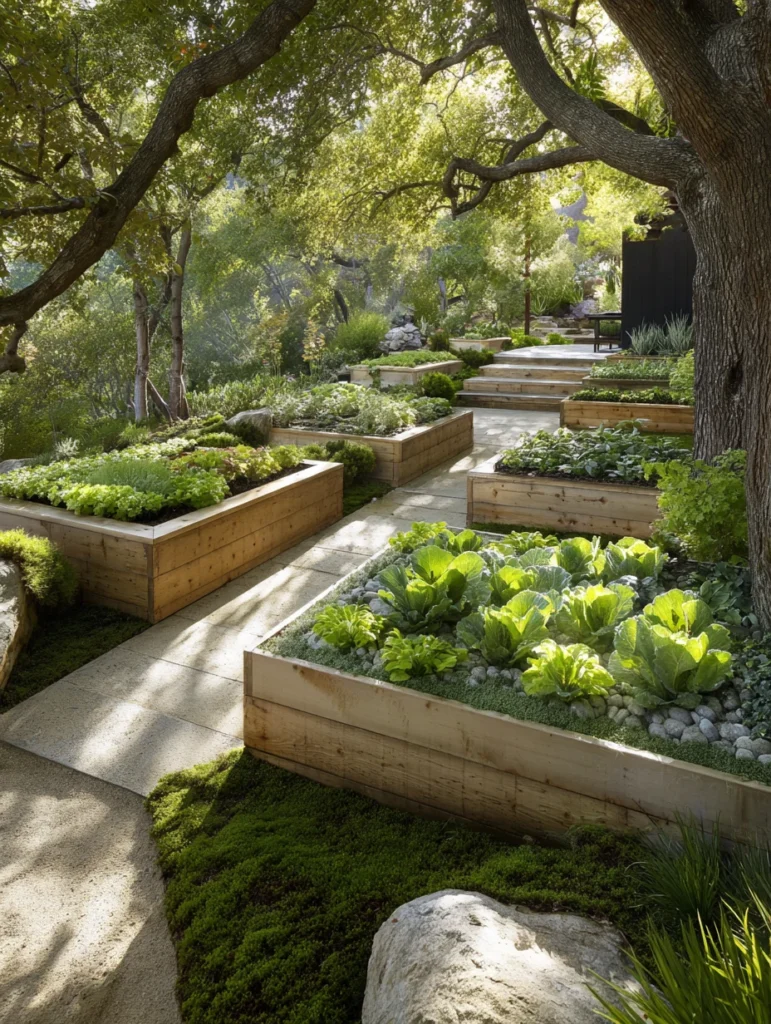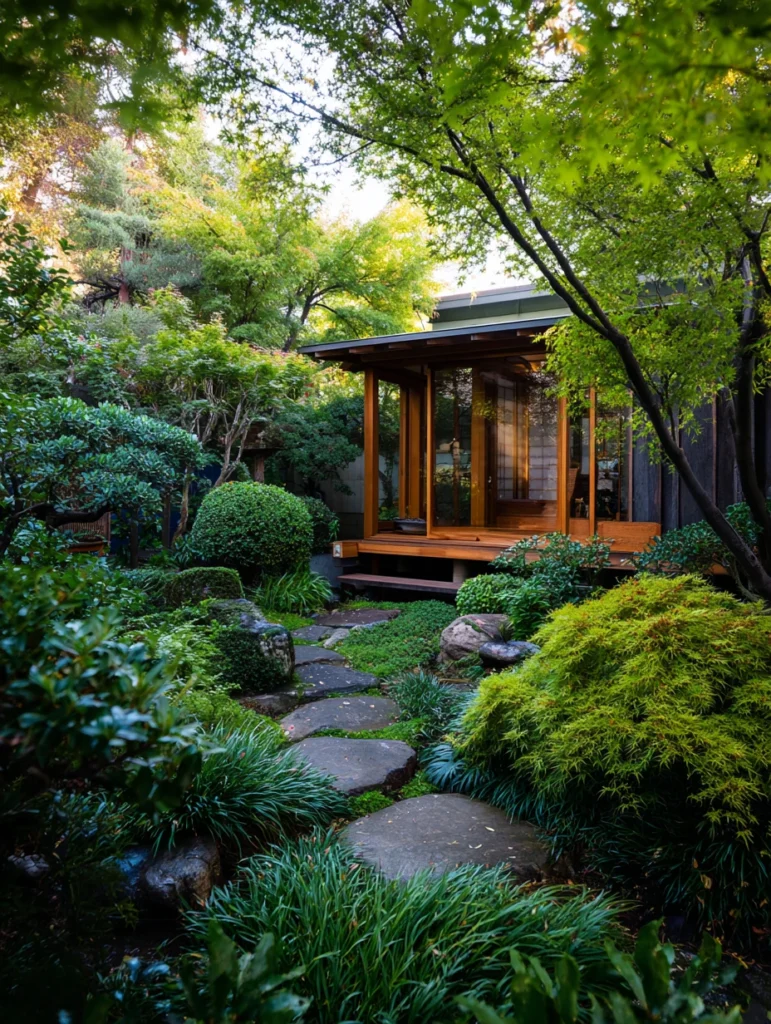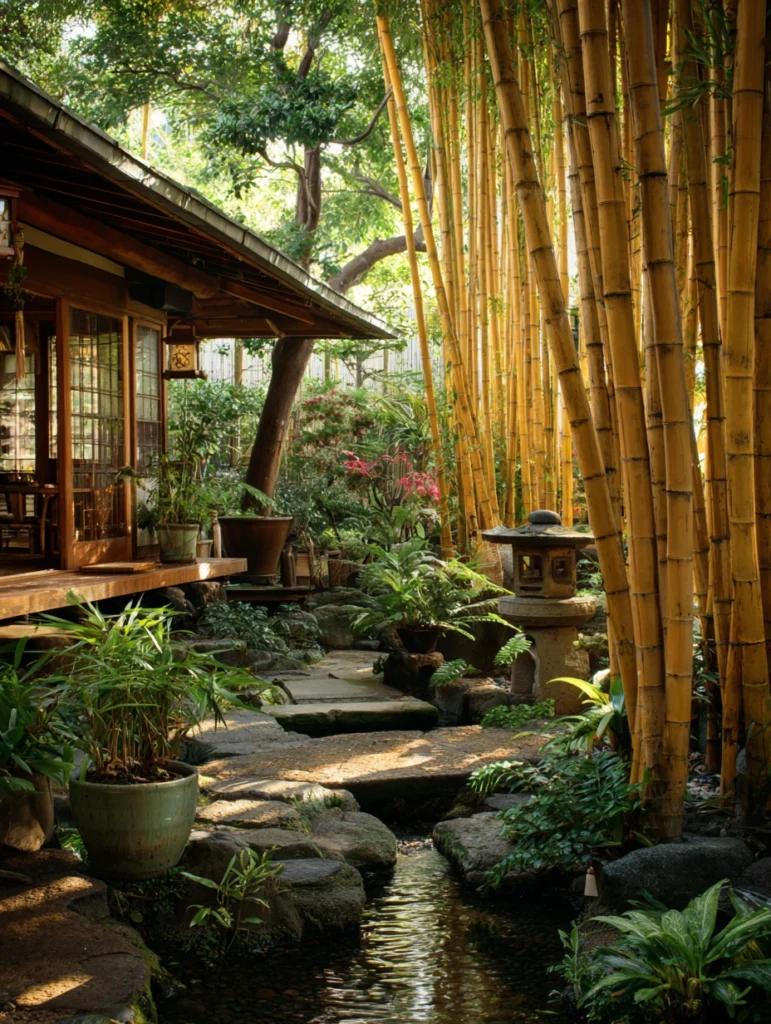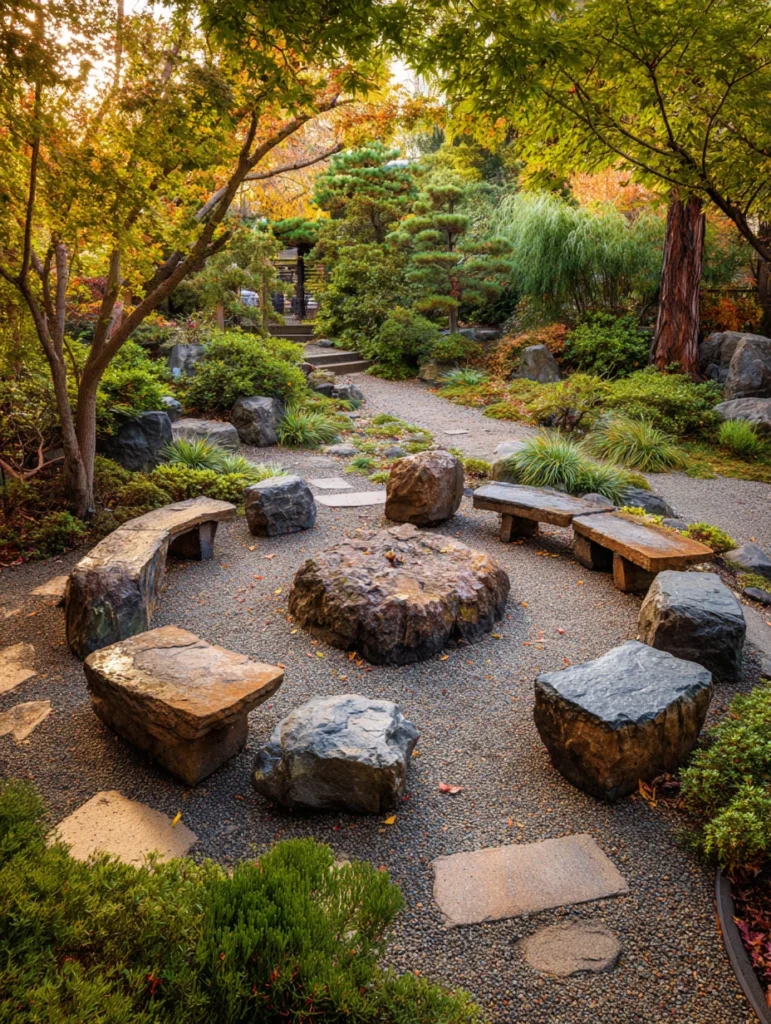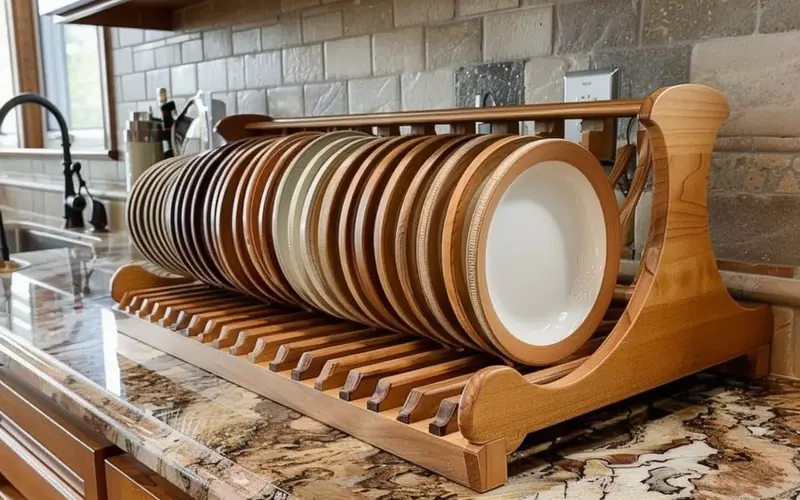There’s something magical about stepping into a Japanese garden. The way the stones are placed, the way the water flows, and the carefully chosen plants – it all feels intentional and peaceful. You don’t need to live in Kyoto to experience that calm. Whether you have a sprawling backyard or a modest corner space, you can bring that serene Japanese aesthetic to your home.
I’ve put together 21 ideas that’ll help you create your own little retreat right outside your door. Some are simple tweaks, others are bigger projects, but all of them capture that authentic Japanese garden vibe. Let’s explore how to transform your outdoor space into a place you truly want to spend time in.
1. Create a Stone Pathway Through Your Garden
A winding stone pathway is the heart of many Japanese gardens, and honestly, it’s one of the most impactful changes you can make. These pathways don’t just look beautiful – they guide visitors through your space and create a sense of discovery. The key is to make your pathway feel natural, as if it’s been there forever. You want stepping stones spaced so someone walks at a contemplative pace, not rushing.
Design approach: Lay your stones in a gentle curve rather than a straight line, and vary the sizes and shapes for visual interest. A random pattern feels more authentic than a rigid arrangement.
Installation method: Start by marking your path with spray paint, then dig shallow holes, approximately two inches deep, for each stone. Fill the gaps with gravel or sand first, then add moss or creeping plants that thrive in your climate.
Product Spotlight: The Yardbird Natural Stepping Stones offer an authentic Japanese look without the premium price tag, and the Stone & Beam Landscape Edging Kit helps define your pathways with clean, defined borders.
Read More: 21 Inspiring Vegetable Garden Design Ideas
2. Install a Small Water Feature or Tsukubai
Water sounds transform a garden instantly. A tsukubai – that traditional bamboo water fountain – doesn’t need to be complicated. You can find modern versions that are simple to install and incredibly soothing. The gentle trickling sound creates a background ambiance that makes your space feel more removed from the outside world.
Sound and atmosphere: The water feature becomes a focal point that naturally draws the eye and ear. It masks street noise and creates a meditative soundscape you’ll find yourself drawn to.
Placement strategy: Position your water feature so that you can see or hear it from a seating area. Bathrooms, entryways, or near a bench all work well for that daily moment of calm.
Product Spotlight: The Zen Garden Tabletop Water Fountain with Bamboo fits nicely into smaller spaces, and the Outdoor Solar-Powered Water Fountain keeps things eco-friendly while adding a peaceful water element.
Read More: 21 Small Zen Garden Ideas for a Tranquil Home
3. Use Gravel and Sand to Define Spaces
Raking gravel isn’t just therapeutic – it’s a functional aspect of Japanese garden design. Different areas of gravel create visual separation and add texture to your landscape, enhancing its overall aesthetic. White or light gray gravel works beautifully, and you can rake it into patterns or leave it in its simple form. This is seriously one of the most affordable ways to upgrade your outdoor space, and it feels intentional without being fussy.
Pattern and texture: Rake your gravel into concentric circles or straight lines to add visual interest. These patterns create movement and draw the eye naturally through your garden.
Maintenance reality: Yes, you’ll want to rake occasionally, but it’s surprisingly meditative once you get the hang of it. The gravel also keeps weeds down and provides good drainage for plants.
Product Spotlight: The White Pea Gravel for Landscaping provides a clean, classic look, and the Japanese Garden Rake Tool Set makes maintenance actually enjoyable rather than a chore.
Read More: 21 Cottage Garden Ideas for a Whimsical Space
4. Incorporate Large Statement Rocks
Big rocks are anchors in Japanese gardens. They’re not random – each stone has a purpose and a specific placement. A moss-covered boulder becomes a sculptural element, a focal point that draws viewers naturally toward it. These rocks age beautifully over time as moss and lichen settle in, adding character and depth to your space.
Selecting the right stones: Look for rocks with interesting shapes and textures. Weathered stones with character beat perfect, shiny new rocks every time. Position them so they appear to have naturally settled there, not as if you just dropped them in place.
Moss development: Moss grows on north-facing rocks in most climates. If you’re impatient, you can actually encourage moss growth with a mixture of moss spores and buttermilk, though waiting for nature to work is part of the charm.
Product Spotlight: The Natural River Rocks for Landscaping offer versatile options for creating balance in your garden, and the Moss Growing Kit accelerates the natural aging process for those seeking faster results.
Read More: How to Design a Container Garden for Your Flowers
5. Design a Tea House Nook or Seating Area
Your seating area should feel intentional and separated from the rest of your space. Even a simple wooden bench tucked under a tree creates that tea house feeling. The idea is to have a spot where you can sit and simply exist in your garden, rather than maintain it. This becomes your sanctuary, your reason for getting outside in the first place.
Space requirements: You don’t need much – even four feet by six feet works. What matters is that it feels intentionally designed and comfortable. Add a small table for tea or a book, and you’ve got your perfect retreat.
Material selection: Natural wood is a more aesthetically pleasing option than metal or plastic. Weathered wood looks even more authentic. Consider a pergola overhead for dappled shade and that enclosed, cozy feeling.
Product Spotlight: The Wooden Garden Bench with Backrest provides that classic seating without overthinking it, and the Outdoor Wood Pergola Kit creates the overhead structure that makes your nook feel intentional and sheltered.
Read More: Amazing Herb Garden Ideas for Your Outdoor Oasis
6. Plant Japanese Maples for Seasonal Color
Japanese maples are the showstoppers of Japanese gardens. Their delicate leaves create dappled shade, and the fall colors are incredible. These trees don’t demand a lot of space or attention, which is perfect if you want beauty without high maintenance. The variety of colors – from deep burgundy to bright green to orange-red – allows you to choose precisely the mood you want for your space.
Growing conditions: Japanese maples prefer partial shade and well-draining soil. They’re slower-growing than many trees, which works in your favor since they stay manageable in size. Once established, they’re pretty self-sufficient.
Seasonal impact: Spring brings fresh foliage, summer provides cooling shade, and fall delivers that spectacular color show. Even winter’s branching structure looks elegant and sculptural when nothing else is leafing out.
Product Spotlight: The Japanese Maple Tree Fertilizer with Sulfur keeps your trees thriving in the soil conditions they love, and the Professional Tree Pruning Tool Set helps you maintain that elegant shape as they grow.
Read More: 21 Corner Garden Ideas to Transform Your Backyard
7. Add Bamboo Elements for Structure and Sound
Bamboo screens, water spouts, and fences instantly bring an authentic Japanese character—bamboo sways in the wind, creating subtle sounds and adding a natural texture that complements the surroundings perfectly. Whether you use it as a privacy screen or an architectural accent, bamboo feels organic without being overdone.
Privacy screening: A bamboo fence or screen creates natural separation without feeling harsh. It filters views rather than completely blocking them, maintaining that open, airy feeling while still defining your space.
Sustainability note: Look for sustainably harvested bamboo. Bamboo grows incredibly fast, making it one of the most renewable building materials available. Your garden update aligns with environmental consciousness.
Product Spotlight: The Bamboo Privacy Screen Fencing provides structure while maintaining that light, natural aesthetic, and the Bamboo Water Fountain Spillway adds movement and sound with authentic materials.
Read More: Stunning Flower Bed Ideas for the Front of the House
8. Cultivate Moss for a Lush, Aged Look
Moss transforms a garden from new and shiny to ancient and established. It softens hard edges, grows between stones, and creates that magical, untouched-by-time feeling. Moss doesn’t need mowing, fertilizing, or the constant attention grass demands. It thrives in shade and damp spots that grass struggles with, making it perfect for problem areas.
Creating moss gardens: Moss grows in ideal conditions – shade, moisture, and slightly acidic soil. Rather than fighting these conditions with traditional grass, lean into them and embrace moss. It’s one of the easiest garden changes with the most significant visual impact.
Maintenance advantages: Once established, moss needs almost no upkeep. It handles foot traffic better than you might think, and it remains green year-round in most climates. The aesthetic benefit far outweighs any care requirements.
Product Spotlight: The Moss Growing Mix and Spore Kit jumpstarts the process, so you don’t have to wait years for natural moss development. The Acidifying Soil Amendment creates perfect conditions for moss to thrive naturally.
Read More: 17 Garden Ideas for Small Spaces and Maximum Yield
9. Create a Gravel Garden with Drought-Resistant Plants
A gravel garden works beautifully in the Japanese style while being practical for dry climates. Gravel, stones, and carefully chosen drought-tolerant plants create visual interest without demanding constant watering. This approach is honest – you’re working with what your climate offers rather than fighting it. Plants like sedums, ornamental grasses, and dwarf conifers thrive in these conditions.
Plant selection: Choose plants with interesting textures and forms, rather than relying solely on their flowers. Foliage becomes your color palette – silvers, grays, deep greens. This restraint is actually very Japanese in philosophy.
Water conservation: Gravel retains some moisture and helps keep the soil cooler. Combined with drought-tolerant plants, you’ll water far less frequently. This garden style makes environmental sense while looking intentionally designed.
Product Spotlight: The Drought-Resistant Plant Variety Pack features species proven to thrive with minimal water, while the Mulch and Gravel Landscape Fabric prevents weeds while retaining the moisture your plants need.
Read More: How To Create a Beautiful Rose Garden To Inspire You
10. Build a Moon Gate or Viewing Portal
A moon gate, those circular openings in Japanese gardens, frames views and creates visual depth. You don’t need a full wooden structure; even an arched trellis can make the same effect. These portals draw the eye through your space, creating moments of discovery as you move through the garden.
Design philosophy: Moon gates prompt viewers to pause and look through to what lies beyond. They break up sightlines and add an element of playfulness. This simple element completely changes how people experience your garden.
DIY possibilities: You can build a basic moon gate frame from wood or metal, or use climbing vines on a circular trellis. The key is creating that opening that makes people want to walk through and see what’s on the other side.
Product Spotlight: The Metal Arch Trellis Garden Structure provides the frame for climbing plants to grow through, and the Premium Climbing Plant Seeds Collection gives you options for what grows around and through your moon gate.
Read More: 21 Stunning Mediterranean Garden Ideas To Inspire You
11. Introduce Water Basins for Reflection
A still water basin reflects sky, trees, and clouds, creating depth and light. These aren’t necessarily functional water features with flowing water; sometimes, simple, still basins work just as well. They add a contemplative quality to your space. You can use anything from an actual stone basin to a simple ceramic bowl, depending on your style and budget.
Placement strategy: Position water basins where they capture morning or evening light. The reflection becomes most beautiful during golden hour. Viewing your basin from a sitting area amplifies its meditative effect.
Maintenance consideration: Keep basins filled and relatively clean. Algae growth is a natural phenomenon and actually adds to the aged aesthetic, but you want water that is clear enough to reflect rather than looking stagnant.
Product Spotlight: The Japanese Stone Water Basin offers authentic styling if you’re committed to the look. At the same time, the Outdoor Water Basin Pump Kit ensures the water remains fresh and flows gently, requiring minimal maintenance.
Read More: How To Create a Magical DIY Fairy Garden for Your Backyard
12. Use Lanterns to Create Focal Points and Evening Ambiance
Stone lanterns, or ishidoro, serve as both sculptural focal points and practical sources of light. These traditional lanterns guide pathways and create a warm glow in the evening. Beyond aesthetics, they provide actual illumination without screaming “modern lights.” Placing lanterns strategically throughout your garden creates visual interest during the day and atmospheric lighting after dark.
Lighting approach: Traditional lanterns are typically powered by candlelight or solar bulbs. Solar options eliminate the need for wiring while maintaining that authentic look. One lantern creates a focal point; multiple lanterns guide movement through your space.
Material choices: Stone lanterns age beautifully and feel permanent. If stone feels too heavy or expensive, modern replicas in composite materials work surprisingly well. The point is the shape and form, not necessarily the authenticity of materials.
Product Spotlight: The Solar Stone Lantern with LED Light combines traditional aesthetics with modern convenience, and the Outdoor Lantern Post Light Set provides multiple lighting points throughout your garden.
Read More: Urban Gardening Solutions: Creating a Small Patio Veggie Garden
13. Establish a Bamboo Fence or Screen
Bamboo fencing creates privacy while maintaining a visually light appearance. Unlike solid wooden fences that feel heavy, bamboo screens filter light and views elegantly. The vertical lines of bamboo also guide the eye upward, making spaces feel larger. Whether you build from scratch or use pre-made panels, bamboo brings authentic Japanese character.
Privacy without harshness: Bamboo screens block unwanted views while allowing air and light to filter through, creating a serene atmosphere. They’re permeable in a way that solid walls never are, maintaining an open garden feel while protecting your space.
Installation options: Full bamboo fencing is suitable for larger spaces, while smaller screens are well-suited for tight areas. You can even use bamboo in containers as a temporary, flexible screen solution.
Product Spotlight: The Pre-Made Bamboo Fence Panels save installation time while guaranteeing consistent quality, and the bamboo screen planter combo provides screening with integrated planting space.
14. Create Layered Planting for Depth and Interest
Japanese gardens utilize layers of planting, including tall trees, mid-level shrubs, and ground covers, to create visual depth. This isn’t about packing plants in; it’s about strategic spacing that allows each plant to breathe while creating layers of texture and color. Viewing your garden from different angles reveals different compositions.
Plant relationships: Taller evergreens provide structure and year-round form. Mid-level plants, such as Japanese holly or dwarf maples, add seasonal interest. Ground covers and moss at the base tie everything together. This vertical thinking creates sophistication without complexity.
Color restraint: Instead of a rainbow, stick to a limited palette – greens with touches of burgundy, or greens with silver accents. This restraint feels intentional and calming rather than chaotic.
Product Spotlight: The Dwarf Ornamental Shrub Variety Pack gives you plants at different heights that work together, and the Japanese Garden Plant Care Bundle keeps your layered planting healthy and thriving.
15. Design a Viewing Stone or Meditation Spot
A viewing stone – a large, flat rock positioned as a seat or standing point – becomes a meditation platform. It could overlook your entire garden or frame a specific view. This practical element transforms your garden from something you maintain into something you experience. You don’t need anything fancy; a well-placed boulder works perfectly.
Positioning strategy: Select a location that provides a pleasing view of your garden or the surrounding area. Height matters – slightly elevated gives you perspective. Sometimes, a viewing stone at ground level feels more intimate and grounded.
Creating the ritual: Your viewing stone becomes a destination within your garden. You’re not just passing through; you’re actively seeking out this spot to sit and take in the surroundings. This intention changes your entire relationship with your outdoor space.
Product Spotlight: The Large Natural Viewing Stone positions your meditation spot intentionally, and the Outdoor Meditation Cushion Set makes sitting there actually comfortable for longer periods.
16. Install a Simple Dry Stream Bed
A dry stream bed simulates water flow using gravel, sand, and stones, even without the presence of actual water. It’s practical for drainage and aesthetically suggests movement through your garden. The curved lines of a dry stream guide viewers through your space naturally. This design element works beautifully in small spaces where an actual water feature isn’t practical.
Design flow: Your dry stream follows the topography – downhill is more natural than flat or uphill. Stones and gravel create texture changes that suggest water movement has occurred. Plantings along the banks complete the illusion.
Functionality: Dry streams manage water runoff while maintaining an intentional appearance. In rainy seasons, actual water can flow through, proving the design’s practicality. You get beauty and function in one element.
Product Spotlight: The Landscape River Rock Variety Pack offers a range of stone sizes for visual interest, while the Drainage Gravel with Landscape Fabric provides a solid foundation for proper water flow.
17. Develop Seasonal Plant Combinations for Year-Round Interest
Japanese gardens offer beauty in every season through the careful selection of plant choices. Spring brings delicate blooms, summer offers cooling green foliage, fall delivers spectacular color, and winter reveals elegant branch structures. Rather than dormant and gray, your winter garden becomes sculptural and interesting. Planning these seasonal shifts keeps your garden feeling fresh and intentional.
Seasonal planning: Spring bulbs beneath deciduous trees, summer ferns and hostas for shade, fall color from Japanese maples and dogwoods, and winter structure from grasses and conifers. Each season has stars that take center stage.
Color transitions: Soft colors in spring transition to lush greens in summer, warm tones in fall, and muted grays in winter. This natural progression feels organic rather than planned-looking.
Product Spotlight: The Four-Season Plant Collection for Japanese Gardens is explicitly curated for year-round interest, and the Seasonal Plant Care Calendar and Guide keep you informed about what each plant requires at each season.
18. Build Raised Beds with Clean Lines
Raised beds in Japanese gardens feature clean, minimalist lines, unlike the rustic look of Western gardens. Treated wood, stone, or composite materials create structured spaces for planting while maintaining that intentional aesthetic. Raised beds also improve drainage and make gardening easier on your back.
Material selection: Avoid treated wood that’s heavily stained or painted. Natural wood or stone that weathers gracefully fits the aesthetic better. The idea is clean lines without visual clutter.
Space efficiency: Raised beds help you maximize growing space while maintaining a neat and orderly appearance. In small gardens, they become the entire planting area. In larger gardens, they anchor specific garden rooms.
Product Spotlight: The Composite Raised Garden Bed System offers clean lines without the need for rotting wood, and the Premium Garden Soil with Compost Blend fills your beds with material that plants actually thrive in.
19. Create Garden Rooms with Strategic Plant Placement
Dividing your garden into distinct areas or “rooms” using plants creates a sense of discovery and exploration. Each room can have its own character while fitting into the overall aesthetic. This design approach makes small gardens feel larger by revealing different spaces as you move through.
Defining space: Tall plants, hedges, or screens separate areas without isolating them, creating a sense of enclosure. You want movement between spaces to feel natural, not blocked. Think of it as arranging your outdoor space like interior rooms.
Purpose differentiation: One area might be for meditation, another for gathering, another for contemplation. This functional thinking makes each space feel necessary and intentional.
Product Spotlight: The Instant Hedge Privacy Plant Kit creates room divisions quickly, and the Garden Divider Screen and Trellis System provides flexible boundaries you can adjust as your garden evolves.
20. Incorporate Bamboo Accents and Details
Beyond full bamboo fencing, smaller bamboo accents add authentic touches. Bamboo supports for plants, water spouts, plant dividers, and decorative elements all work beautifully. These details accumulate to create an overall aesthetic that feels intentionally Japanese without being theme-park-like.
Detail-oriented design: Bamboo details work best when they’re both functional and beautiful. A bamboo plant support that actually helps your plant grow feels better than purely decorative bamboo.
Versatility: Bamboo suits both modern and traditional settings due to its clean lines and natural material. It bridges contemporary sensibilities with traditional Japanese design principles.
Product Spotlight: The Bamboo Plant Support and Trellis Set provides functional beauty for growing plants, and the Decorative Bamboo Accent Pieces Collection adds finishing touches throughout your space.
21. Design a Gravel Seating Circle or Gathering Space
A central gathering space anchors your garden, providing a focal point and destination. A simple gravel circle with a few seating options creates an informal gathering space that doesn’t require a patio or structure. Surrounding plants provide privacy and shelter. This space becomes the heart of your garden, where the real magic happens.
Layout philosophy: Your gathering space should feel intentional without being too formal. Uneven numbers of seating work better than pairs – three rocks or seats feel more natural than two. The circular form references the moon gate, creating a gentle energy flow.
Intimacy factor: Enclosed by plants but open to the sky, your gathering space strikes a balance between exposure and shelter. You’re outside but protected, visible but private. This balance makes people want to spend time here.
Product Spotlight: The Outdoor Seating Stone Collection offers multiple options for creating comfortable gathering spaces, and the Gravel Base Kit with Edging clearly defines your circle without fuss.
Final Thoughts
Your Japanese garden won’t happen overnight, and that’s actually part of the beauty. These spaces develop character over time as moss grows, plants mature, and elements weather naturally. Start with one or two ideas that speak to you – maybe a pathway and a seating area – then add more as the space calls for it.
The goal isn’t perfection; it’s creating somewhere that feels intentional and calm. Every rock placement, every plant choice, every detail matters. Before you know it, you’ll have your own sanctuary right outside your door. Now get out there and start building your peaceful retreat!
